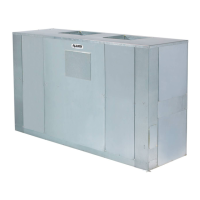Page 94
C2-1 DIAGRAM WITH D5 DIAGRAM
Electromechanical Thermostat with Modulating Economizer and Warm-up
7-C2-1 Section with D5 Section
An optional feature of the REMD16M and EMDH16M Economizer is a warm-up kit which holds
economizer outdoor air dampers closed during night heat operation and while the GCS16 is
warming the building after night setback. The warm-up kit temporarily disables the economizer
(outdoor dampers are held closed) during morning warm-up to keep cool outside air from being
mixed with return air. Once the temperature setpoint is reached, the economizer is allowed to
operate normally (outdoor air dampers open to minimum position to allow required minimum air
exchange.
NOTE - In order to understand how optional controls affect operation of the GCS16, you must
first read and understand how all the GCS16 components work.
NOTE -
1-The warm-up kit requires the use of optional time clock CMC3-1.
2-Optional field installed night relay K11 (may or may not be factory installed in economiz
er) and night thermostat S12 are also required.
3-The warm-up kit can only be applied to GCS16's with economizer.
WARNING - CONNECT ONLY RELAY KITS DESIGNED FOR THIS CONTROL SYSTEM.
RELAY KITS DESIGNED FOR OTHER CONTROL SYSTEMS ARE NOT COMPATIBLE
AND CONTROL DAMAGE OR FAILURE WILL RESULT. FOR EXAMPLE, A W973
RELAY KIT MUST NOT BE CONNECTED TO A ELECTROMECHANICAL THERMO
STAT CONTROL SYSTEM.
WARNING - BE CAREFUL TO CONNECT RELAY KITS TO THE PROPER JACK AND
PLUG IN THE GCS16 BLOWER COMPARTMENT. REFER TO WIRING DIAGRAM. IM
PROPER CONNECTION WILL CAUSE CONTROL FAILURE.
The warm-up kit mounts in the control mounting area of the GCS16 blower compartment. No
wiring is required. Jumper plug P3 is removed and discarded. Warm-up kit harness plug P8
connects directly into jack J3 in the blower compartment. Warm-up kit harness jack J8 con
nects to economizer harness plug P4.
Operation Sequence:
NOTE-This operation sequence emphasizes warm-up kit operation. Unit diagram has been
omitted.
1- When relay K41 is energized during normal operation, the economizer functions normally and
is locked in until night setback.
2- Economizer outdoor air dampers drive full closed anytime blower B3 is not operating.
Night Setback:
3- Time clock CMC3-1 should be adjusted so that clock contacts remain closed during hours
when the building is not occupied. The contacts are set to open shortly (usually 1 hour) before
the building is to be occupied.
4- When clock contacts close, relay K11 in the economizer and K42 in the warm-up kit are ener
gized.
5- Contacts K11-1 open to disconnect power to thermostat S1. K11-2 contacts open to drive the
dampers full closed.
6- Contacts K42-1 open to disengage relay K41.
7- When relay K41 disengages, power is disconnected to the economizer:
a-Contacts K41-1 open to lock out economizer operation.
b-Contacts K41-2 close (not used).
c-Contacts K41-3 open to disconnect power to the economizer.
d-Contacts K41-4 open (not used).
8- During unoccupied periods, K11-1 opens and S1 is disabled. When S12 closes, power is re
turned to S1 and the unit operates (heating demand) normally. When S12's setpoint is
reached, S12 opens, S1 is disabled and unit operation stops.
9- Blower operates only on demand energized by GCS16 heat relay K25 when S12 is closed.
10- Thermostat S1 and economizer remain inoperable until time clock CMC3-1 contacts open.
First Heat Demand After Night Setback (Begin Warm-Up)
11- Shortly before the building is to be occupied, time clock CMC3-1 contacts open.
12- Relay K42 disengages and contacts K42-1 close.
13- Relay K11 disengages. Contacts K11-1 close to allow power to thermostat S1. Contacts
K11-2 close to allow outdoor air dampers to open. Note that dampers remain closed until re
lays K3 and K41 are energized.
14- Since contacts K40-1 are normally closed and contacts K42-1 have just switched closed, tim
er DL7 is energized. Timer DL7 is normally open and closes 30 sec. after being energized.
15- If heat demand W1 reaches relay K40 before delay DL7 closes, contacts K40-1 open, delay
DL7 loses power and resets and the economizer is locked-out for the first heat demand by
relay K41 (contacts K41-3 remain open). If heat demand W1 reaches relay K40 after delay
DL7 closes, relay K41 energizes and the economizer locks in for the day until night setback.
16- When first heat demand is satisfied, relay K40 disengages and relay contacts K40-1 close.
Relay contacts K42-1 are already closed (clock contacts open). Time delay DL7 begins 30
second count. If a second heat demand W1 reaches relay K42 within 30 second, delay DL7
loses power and resets. If a second heat demand W1 does not reach relay K42 within 30 sec.,
time delay DL7 contacts close and relay K41 energizes.
17- When relay K41 energizes, the economizer is allowed to operate normally, controlled by relay
K3:
a-Contacts K41-1 closes to lock in economizer operation until night setback.
b-Contacts K41-2 opens (not used).
c-Contacts K41-3 closes to allow power to the economizer.
d-Contacts K41-4 closes (not used).
18- Once energized, relay K41 locks in and the economizer operates until relay K42 is energized
by night setback (contacts K42-1 open to disengage relay K41).

